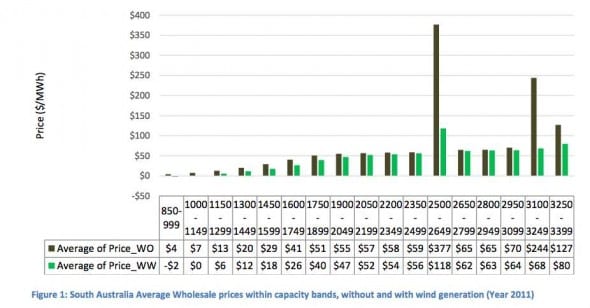Why The Fossil Fuel Industry Hates Wind Power
Originally published on RenewEconomy by Giles Parkinson.
Wind energy has a significant impact on wholesale prices, particularly in those peak demand events when fossil fuel generators used to make most money.
New research from the University of Queensland has added more understanding about why fossil fuel generators hate wind energy, and why they are seeking to bring the renewable energy target to a halt, or at least have it greatly reduced.
The research from the Energy Economics and Management Group in the School of Economics shows that wind energy – particularly in South Australia and Victoria – has a big impact on wholesale prices, but not just at night-time when wind energy blows the most, and demand is normally lowest.
It has the most dramatic impact on pricing during those peak events that usually occur during the day or early evening.
It has long been recognized that fossil fuel generators make a large part of their revenue and profits during those peak events, when expensive peaking plant is brought into production. Prices can soar above $10,000/MWh, and even the “cheap” coal fired generators get that price.
The university research shows that these peak event prices have been sharply reduced by the impact of wind energy.
In Victoria in 2011, its modeling showed that without wind, and using only thermal generation to meet the peak demand, cost $338 million. That is almost 20 per cent of annual revenue from just 6.5 hours of peak demand.
But when wind energy is included, the cost of those peaks is reduced to just $126 million. The impact on fossil fuel generators should not be underestimated, because the finance of some coal generators had been heavily geared with debt on the assumption that these revenue events would provide funds to meet interest payments.
In a one hour peak period on January 31, 2011, from 10.30am, the heavy demand required the most expensive forms of generation to dispatch, which raised the price to the maximum and a wholesale cost of $45.6 million when only thermal generators could respond.
But the inclusion of wind power and its very low marginal cost reduced that half hour to just $1.4 million of wholesale cost.
 Chip in a few dollars a month to help support independent cleantech coverage that helps to accelerate the cleantech revolution!
Chip in a few dollars a month to help support independent cleantech coverage that helps to accelerate the cleantech revolution!
A similar impact was experienced in South Australia, which has the highest penetration of wind farms, with some 1,200MW of capacity accounting for more than a quarter of generation in the 2012/13.
The modelling done by the university showed again that the impact was greatest at times of highest demand – without wind generation the spot prices ranges from $1,000 to $6,000/MWh, but with wind they ranged from $200 to $1600/MWh. (See table below).
The research shows that states that have the highest penetration of wind farms generally experience the greatest reduction in prices. The impacts in NSW and Queensland were more muted because of the relatively small number of wind farms.
Have a tip for CleanTechnica? Want to advertise? Want to suggest a guest for our CleanTech Talk podcast? Contact us here.
Latest CleanTechnica.TV Video

CleanTechnica uses affiliate links. See our policy here.


